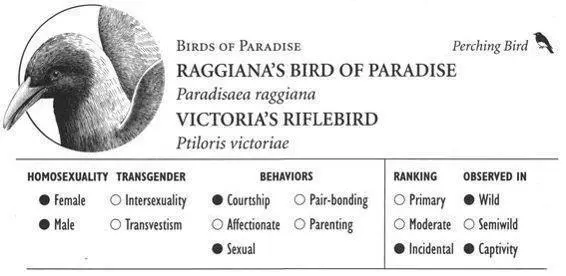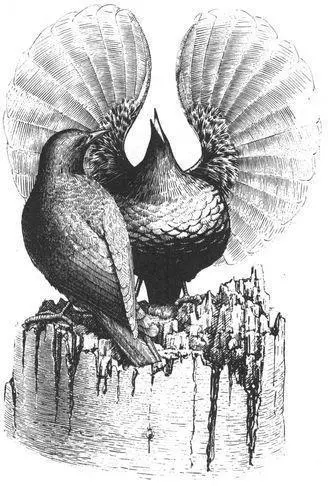*Röell, A. (1979) “Bigamy in Jackdaws.” Ardea 67:123–29.
———1978) “Social Behavior of the Jackdaw, Corvus monedula, in Relation to Its Niche.” Behavior 64:1–124.
Trost, C. H., and C. L. Webb (1986) “Egg Moving by Two Species of Corvid.” Animal Behavior 34:294–95.
BIRDS OF PARADISE, BOWERBIRDS, AND OTHERS

RAGGIANA’S BIRD OF PARADISE
IDENTIFICATION: A crow-sized bird; male has a bright yellow head, an iridescent green throat, and a long “tail” of orange flank feathers; female has a duller yellow head and brown facial mask and no orange “tail.” DISTRIBUTION: Southern and northeastern Papua New Guinea. HABITAT: Lowland and hill forests. STUDY AREA: In captivity at the Baiyer River Sanctuary, Mt. Hagen, Papua New Guinea; subspecies P.r. augustaevictoriae.
VICTORIA’S RIFLEBIRD
IDENTIFICATION: Adult males are black with an iridescent sheen and metallic crown, throat, and central tail feathers; females and younger males are drabber, with brown, buff, and off-white plumage. DISTRIBUTION: Northeast Queensland, Australia. HABITAT: Rain forest, eucalyptus forest, swamp woodlands. STUDY AREAS: Southern Atherton Tableland, Queensland, Australia, including near Townsville and in the Ingham and Palmerston National Parks.
Social Organization
Male Raggiana’s Birds of Paradise perform courtship displays on communal “courts” or LEKS (located in tree branches) in groups of up to eight individuals at a time; females visit the leks in pairs or small groups. Male Victoria’s Riflebirds display singly. Both species have a polygamous or promiscuous mating system, in which males copulate with more than one female but do not participate in any parental duties.
Description
Behavioral Expression: Male Victoria’s Riflebirds sometimes court younger males with a series of spectacular displays (also seen in heterosexual courtships). Adult males attract individuals of both sexes to their display perches by repeatedly calling with a loud yass note and opening their bills to expose the bright yellow mouth interior. When an interested male (or female) approaches, the courting male begins his CIRCULAR WINGS AND GAPE display, in which he fans his wings to form a perfect circle with the tips meeting above his head while simultaneously raising and lowering his body. The wing circle is held vertically as he gapes his bill and presents his iridescent throat feathers to the other male. If the latter lands on the display perch, the courtship progresses to its final phase, the astounding ALTERNATE WINGS CLAP display. The adult male begins swaying and twisting his body from side to side, alternately raising and lowering each wing so that they “clap” with a dull, thudding sound when they meet above his head. Gradually the wings are brought forward while being clapped so that they encircle the younger male. The tempo of the display is increased until, at its climax, the wing-clapping reaches an astounding speed—each wing alternately encircles the observing male at a rate approaching twice a second. The courted male becomes mesmerized by the brilliant metallic bluish green throat shield of the displaying male as it is jerked violently back and forth, and he may respond by simultaneously performing his own alternate wings clap display. If both males are displaying, they alternate wing movements, gradually crouching while arching their heads back and quivering all over. They often perform several bouts of mutual display with brief rests between each. Occasionally one male briefly mounts the other; full copulation does not usually occur, though, since the mounted male often simply flies away from underneath the male mounting him.
Courtship displays between female Raggiana’s Birds of Paradise involve some of the same postures and movements used in heterosexual courtship in this species. One female arches her wings above her back and then claps them against her sides, all the while bobbing up and down and erecting the feathers on her back and flanks as she dances in front of the other female. Every now and then she makes an ur, ur call, and she may even hang upside down on a branch while flicking her wings and calling. This dramatic pose is held for a minute or more at a time. Males use this inverted posture to show off their orange “tail” plumes during courtship, but females perform this display even though they do not have such ornate feathers. Sometimes two females engage in mutual display, facing each other while holding their wings stiffly above their backs and bobbing.
A male Victoria’s Riflebird courting another male with the “circular wings and gape” display

Frequency: Courtship displays between male Victoria’s Riflebirds occur fairly often at some times of the year, especially during the postmolting period in February and March. Although homosexual mountings are not common in this species, opposite-sex matings have in fact been seen only a few times during more than a hundred courtship displays observed in the wild.
Orientation: At least some male Victoria’s Riflebirds are functionally bisexual, courting and attempting to mate with both males and females. In Raggiana’s Bird of Paradise, courtship display between females has so far only been observed in captivity in the absence of males, so this behavior may be the expression of a potential or “latent” bisexual capacity. More detailed field observations and life histories are required, though, before any definitive statements can be made regarding the sexual orientation of individuals that engage in this activity.
Nonreproductive and Alternative Heterosexualities
Only about 11 percent of lek visits by female Raggiana’s Birds of Paradise actually result in heterosexual mating. More often than not, a courtship interaction is broken off by a female before copulation occurs. In addition, males often chase females and behave aggressively toward them on the lek, which deters them from participating in sexual interactions. When mating does take place, the female often mounts the male prior to copulation. Such REVERSE mounts are then followed by a display in which the male appears to pummel his partner with his wing. The female crouches on her perch absorbing the blows for 20—35 seconds, after which copulation occurs. Nonreproductive matings also take place outside of the breeding season. Many males may delay breeding up to five or more years once becoming sexually mature, since they do not generally acquire their ornate plumage (used in courtship displays) for several years.
Other Species
Male Greater Birds of Paradise (Paradisaea apoda), a species closely related to Raggiana’s, also sometimes court and mount younger males.
Sources
* asterisked references discuss homosexuality/transgender
Beehler, B.M. (1989) “The Birds of Paradise.” Scientific American 261(6):116–23.
———(1988) “Lek Behavior of the Raggiana Bird of Paradise.” National Geographic Research 4:343–58.
*Bourke, P. A., and A. F. Austin (1947) “The Atherton Tablelands and Its Avifauna.” Emu 47:87–116.
Davis, W. E., Jr., and B. M. Beehler (1994) “Nesting Behavior of a Raggiana Bird of Paradise.” Wilson Bulletin 106:522–30.
Читать дальше














